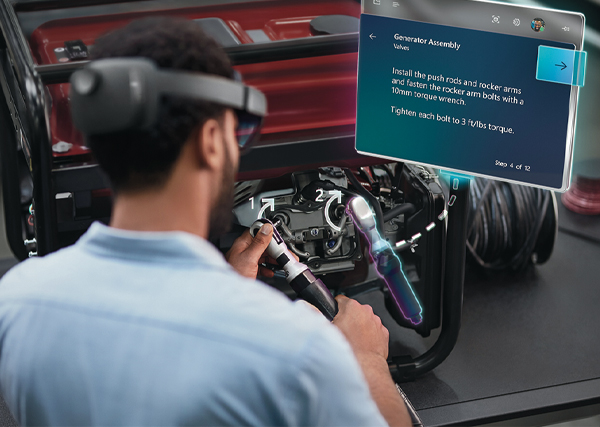
4 Ways Augmented Reality Is Impacting Learning and Development

In the words of Benjamin Franklin – ‘Tell me and I forget. Teach me and I learn. Involve me and I remember.’
Technology has been transforming the learning and development landscape for a number of years, with the introduction of blended and experiential learning methodologies to involve trainees as much as possible.
Now, immersive technologies, such as Augmented Reality (AR), Virtual Reality (VR), and Mixed Reality (MR) are helping businesses and educational institutions to deliver smarter, safer, and more effective learning experiences both inside and outside of the classroom.
The Rise of Augmented Reality
A recent survey by the Consumer Technology Association (CTA) discovered that workforce training topped the list of use cases for AR in the enterprise.
55% of businesses are currently using AR in training and/or teaching, while 27% plan to use it within the next year.
One of the drivers behind the rise of AR within learning and development is the fact that these experiences can be activated using hardware that is widely available – such as smartphones and tablets. It is also a more cost-effective solution, as the technology superimposes a computer-generated image, information, or data into peoples’ real-life surroundings, rather than recreating an entirely virtual environment.
How Augmented Reality Is Changing The Face of Learning and Development
1. Moving learning beyond the classroom
Not everyone learns in the same way. Different styles of learning—auditory, visual, tactile, kinesthetic, or a mix—aren’t always well represented in training programmes. Moving away from the classroom and closer to the application environment is proving more beneficial, and augmented reality can bridge this gap.AR can enable businesses to digitally recreate realistic working environments and scenarios. For example, pharmaceutical manufacturers can use AR to train staff on a piece of machinery that is too costly to take out of service for training purposes. Instead of watching videos and reading extensive manuals, the staff has the opportunity to interact with a life-size digital replica of the machine itself and safely simulate potentially dangerous processes typically only experienced in the field. This capitalizes on a mix of learning styles to improve knowledge retention and can all be done remotely, reducing logistics costs and time spent associated with delivering training.
2. Capturing expertise and transferring knowledge
In certain industries, skills gaps have arisen as a result of factors such as experienced workers retiring, a reduction in the number of apprentices, and even other technological advancements. To close these gaps, businesses need to capture the expertise they have and ensure the knowledge is quickly and effectively transferred to the next generations coming through.
Rather than capturing this content in physical manuals or electronic documents, augmented reality can be used to create seamless step-by-step workflows that guide staff in real-time. By digitally overlaying instructions or checklists onto a real-world scenario, less experienced team members can instantly feel confident carrying out standard operating procedures without the need for extensive training beforehand. This greatly reduces the on-ramp times for new employees.
If problems do crop up, more experienced technicians can then provide remote assistance using augmented reality. The technology can enable technicians to offer ‘over-the-shoulder’ support without physically needing to be present. They can directly see what their colleague sees on the floor, adding digital elements, such as annotations or notes, into their field of view to assist. Through this process, knowledge transfer naturally occurs. It also instantly increases the scalability and accessibility of expertise within a business, as more experienced technicians can offer support to multiple sites without needing to be located nearby.
3. Delivering greater engagement
With diminishing attention spans and mounting to-do lists, businesses are looking at how they can provide nuggets of training content that drive staff engagement and meet specific learning objectives.
One of the benefits of delivering this bite-sized content using AR is the fact that immersive experiences are proven to deliver greater engagement. The fact that AR applications can be activated anywhere, anytime using a smartphone or tablet means staff can access the content when it suits them best. Businesses can even add realistic 3D digital avatars to offer assistance.
Learning and development programmes are also a natural place for gamification. Integrating gamified AR elements results in higher completion rates, as well as better recall and retention. The addition of rewards and leaderboards also adds an element of fun to the overall learning experience.
4. Generating actionable insights
Augmented Reality experiences are typically delivered through a mobile application, meaning businesses can also gather actionable insights from users as they complete certain tasks. In a training environment, this data can then be used to drive improvements to future learning and development initiatives, helping them to build a more competent and productive workforce.
By Fuzzy Logic Studio
472 Views
Recent Posts
- New Resource: Testing Solutions for Lithium-Ion Batteries
- Mother’s Day Dining At The Riverside
- FREE WEBINAR | Static Electricity: The Shocking Truth! The Risk Of Electrostatic Phenomena in Explosive (ATEX-) Environments
- Unlocking New Opportunities through Social Value
- Upgrade Historical Items With Newer Versions……
Back to News >



